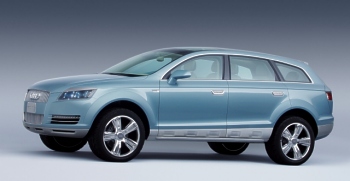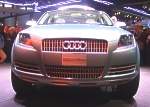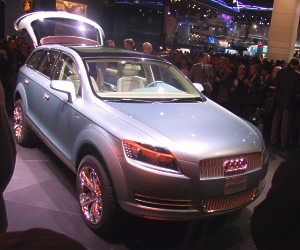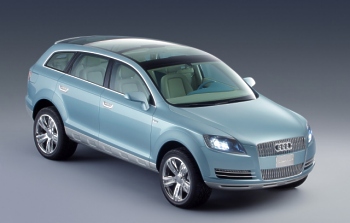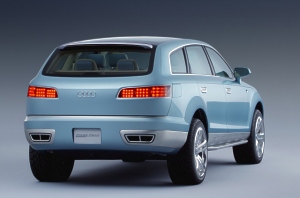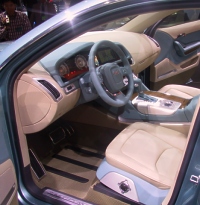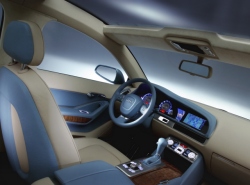
.
. .
..
. . . . . "Pikes Peak" production version bears the name Q7 The large sport utility vehicle (SUV) that is to be built by the Audi brand will bear the name Q7. This announcement was made at the Paris Motor Show 2004 by Prof. Dr. Martin Winterkorn, Chairman of the Board of Management of AUDI AG. "The letter Q denotes a new type family within our company, alongside A, S and RS. The 7 indicates that it is positioned between the A6 and A8," explained Prof. Winterkorn. The Q7 will make its market debut at the start of 2006. The production version will be based on the Pikes Peak quattro concept study that Audi had unveiled at the 2003 Detroit Motor Show. In common with the latter, the five-door, seven-seater Q7 will combine the qualities of a fully-fledged off-road vehicle with the typical dynamism of an Audi high-performance sports saloon. The Audi SUV will moreover offer an amount of space that sets new standards in its class.
Audi Concepts Audi Production Cars Related Topics
© 1998 - 2006
Copyright & |
Audi : Audi Pikes Peak Concept
Premiere in Detroit: at the North American International Motor Show (January 5 to 20, 2003) Audi is exhibiting a sport concept study: the Pikes Peak quattro, for all on-road driving and moderate off-road terrain. It has been developed exclusively for this debut at America's most important automobile exhibition.
It is a gathering place for automobile enthusiasts on account of the "Pikes Peak International Hill Climb Race". Every year in June, up to 160 fearless drivers tackle this 12.4 mile (almost 21 kilometer) long run, which has straights on which 125 mph (200 km/h) can be reached but also 156 corners with loose stone surfaces, unprotected by any form of crash barrier. Three victories have made the Pikes Peak International Hill Climb Race part of the successful history of Audi Motorsport. In 1985 it was won by Michèle Mouton, the first woman driver ever to win a world championship rally. A year later, the legendary American race driver Bobby Unser proved to be unbeatable, and in 1987 Walter Röhrl in the Audi Sport quattro S1 scored a much-admired overall victory by conquering the Peak in the new record time of 10:47.85 minutes. The qualities possessed by the Audi Pikes Peak quattro exhibit definite parallels with the world of rallying, that high-speed sport mostly conducted on loose-surfaced roads and tracks. However, the Audi Pikes Peak quattro for 2003 is considerably more versatile than the Audi Sport quattro that was so successful 15 years ago. The idea behind the Audi Pikes Peak quattro This four-door 4+2-seat hatchback is a draft design that indicates the systematic evolutionary path that current Audi design could take - but it is more besides: the Pikes Peak quattro illustrates the novel AUDI AG concept that spans several segments in the premium automobile category. The Audi Pikes Peak quattro is a crossover model. It possesses typical qualities from a number of different automobile categories. From the luxury sport sedan it adopts dynamism and comfort, but its off-road competence comes from its variable-height adaptive air suspension and quattro driveline. This is not all: the Audi Pikes Peak quattro is equally convincing with its innovative seating concept with variable elements as used in luxury vans. Design with character The Audi Pikes Peak quattro is a typical Audi interpretation of what form a striking, sporty crossover model with strong premium affinities could take. Generous curves, clearly defined outlines and muscular, taut surfaces of large area are here united in an architecture in which tranquil beauty and athletic tension create an intriguing contrast. The outer surfaces, accented with swage-lines and interesting panel gap patterns, add vitality to the styling. To strengthen this impression, a bright "Polar Silver" metallic paint finish has been chosen. Although the Audi Pikes Peak quattro conveys a strong impression of strength and security, it cannot be said to lack sporty elegance. At the front, the Audi Pikes Peak quattro has a radiator grill divided into two sections horizontally, with a boldly shaped surrounding frame. PAX wheels of size 295/770 R 560 A (equivalent to a visible wheel diameter of 20.6 inches) help to keep the vehicle controllable if there is a sudden loss of tire pressure. Their 'run-flat' construction means that mobility is maintained if a tire failure should occur, and the vehicle can be driven for up to 125 miles (200 kilometers) at speeds up to 50 mph (80 km/h). The interior: a new and welcoming ambience
Matt-brushed aluminum and Japanese "Tamo" ashwood trim elements give it sporty and technical, but also natural, welcoming accents. A glass roof offers the occupants a panoramic view and a sense of space and light. The clear outlines featured in the driver's area are emphasized by a raised center console that adds to the dignified, sporty impression created by the entire interior. A novel type of display using 3D laser optics makes the instruments brilliantly legible even when vision is otherwise poor. For optimized occupant protection, two neatly housed additional "out of position" cameras identify the front passenger's seated position and modify triggering of the airbag appropriately. The gear shift gate and the Audi-MMI unit (Multi Media Interface) are located conveniently and ergonomically for the driver. By dividing up the center console asymmetrically in this way, space is created on the front passenger's side for a convenience package comprising two cup holders and a shelf for small items. There is a cold-store compartment under the split armrest. All the centrally located controls have polished aluminum surrounds and clear-glass covers to add visual impact to the interior. Six people can travel in the Audi Pikes Peak quattro on three pairs of leather-upholstered seats. The decision to adopt a 4 + 2 seating layout emphasizes the concept study's premium character, with no cramped center seat accommodation above the prop shaft tunnel, but instead a well-balanced blend of luxury and functional efficiency. All seats in the Audi Pikes Peak quattro have a wide range of electrical adjustment. To simplify access to the rear seats, those in the second row have an easy-entry function. If bulky loads have to be carried, the two rear pairs of seats can be folded down so that their backs extend the load area up to a capacity of 68 cu. ft (1,950 liters) when needed. The rear seat is also folded electrically. In the Audi Pikes Peak quattro the MMI display is not available only to the front seat occupants. Two 6.8 x 5.1 inch (173 x 130 mm) screens fold down from a console in the roof lining to provide both information and entertainment for those sitting in the second and third rows. DVD and MD drivers in the retractable center console, a separate MMI with Internet access and USB and headphone plug connections are provided so that the passengers have access to a varied selection of entertainment facilities. Reaching a strong conclusion: rear-end design For easy loading, the tailgate of the Audi Pikes Peak quattro extends into the rear side panels; it is opened and closed electrically by remote control. Hand baggage can be placed in the load area through the rear window, which opens separately. Eight-cylinder, 500 hp engine with twin turbochargers and direct gasoline injection Well known from the Audi RS 6, the V8 engine with twin turbochargers has been further developed and now has a power output of 500 hp. A decisive factor in this power hike is the advanced FSI direct gasoline injection principle, which indicated that new standards were about to be set when it was used on the competition cars that scored historic victories in the 2001 and 2002 Le Mans 24-Hour races and in the American Le Mans Series. Powerful FSI engines are already in production for the Audi A2 and A4 models. In the Audi Pikes Peak quattro the eight-cylinder twin-turbo FSI engine is notable for its free revving and vigorous pulling power at all engine speeds. It accelerates the Audi Pikes Peak quattro from 0 to 100 km/h in only 5.0 seconds (0 - 60 mph in 4.7 sec) and takes it on to a governed top speed of 155 mph (250 km/h). Its maximum torque of 630 Newton-meters is available from as low an engine speed as 2000 rpm upwards and remains constant over a broad speed range. This supreme, massive pulling power is ideal for fast cross-country driving and for negotiating off-road sections of the journey. Ultimate progress on all roads The standard torque split between the axles is 50% to the front and 50% to the rear, but if wheelspin occurs at either axle the split is diverted to the axle with more grip. The electronic differential lock (EDL) controls torque distribution between the two wheels on an axle. Then there is the Electronic Stabilization Program (ESP), which assists the driver when potentially critical driving situations close to the handling limit have to be mastered. Like all Audi quattro cars, the Pikes Peak quattro provides the best possible traction on all surfaces and in all conditions. A warning that an unintentional lane change is taking place is then given to the driver as a means of avoiding a possible accident. Also installed on the Audi Pikes Peak quattro: adaptive cruise control, which not only performs the functions of a conventional cruise control system but also maintains the desired distance from the vehicle in front automatically. Adaptive air suspension A special feature of the Audi Pikes Peak quattro is its variable-height adaptive air suspension. This Audi system makes the Pikes Peak quattro into a most impressive all-rounder. Ample ground clearance - up to 11 inches (280 millimeters) for crossing rough terrain - can be preselected at the MMI; at high speeds, the body can be lowered so that its center of gravity is lower and its aerodynamics are optimized. When developing new vehicle concepts, Audi deliberately goes beyond conventional limits. Short-lived fashion trends are not the objective - Audi's aim is to establish new milestones. The Audi Pikes Peak quattro is yet another example of this. The Audi Pikes Peak quattro shows that the existing definition of the SUV (Sport Utility Vehicle) must be modified, and new values added. It extends the activity component in this definition to include such typical Audi attributes as the quattro driveline with variable-height adaptive air suspension, and matches the dynamic road performance of many a high-class sports car. With its 4 + 2 seating system, which is operated electrically and therefore needs no manual effort, it adds a new quality to the term versatility. And in addition, its sporty, elegant styling is visually satisfying. The Audi Pikes Peak quattro is therefore more than another SUV: it unites the best characteristics of several different automobile worlds at the very highest level, to achieve a hitherto unattained level of overall harmony. Pictures source: Audi AG
|
.
|




 Avantissimo
Avantissimo











